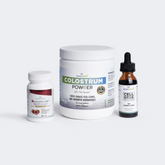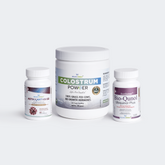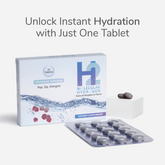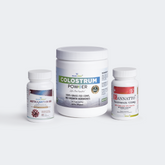Estimated Reading Time: 10 minutes
|Having a new baby is one of the most special times in your life. But let's be honest; it can also feel overwhelming. New moms often have many questions, especially about feeding their babies. One of the most common ones is: "When will my breast milk come in?"
Whether you are a first-time mom or an experienced one, understanding the role of a mother in milk production is crucial. If you are pregnant and preparing for breastfeeding, knowing how your body starts producing colostrum and prepares for milk even before birth can help you feel more confident.
This article explains everything you need to know simply, from how and when your body makes milk to what to do in case of delay.
The Three Stages of Breast Milk
Your body starts to produce milk before your baby is even born, and this process actually begins during pregnancy. Hormonal changes during pregnancy, including high levels of progesterone, prepare the breasts to produce milk. After birth, a drop in progesterone allows milk production to increase.
It's important to remember that each woman's experience with the timing and signs of milk coming in can be unique. Breast milk comes in three stages, which help your baby grow and stay healthy.
1. Colostrum (Birth to Day 2–5)
The first milk your body makes after birth is called colostrum. It's thick, sticky, yellow, or golden-colored. That's why people sometimes call it "liquid gold."
Even though there isn't much of it, colostrum is full of nutrients, potent antibodies, and immunoglobulins. These help support the newborn's immune system and protect against infection, helping newborns fight off sickness in their first days of life.
Some women may notice leaking colostrum from their nipples during late pregnancy or in the first days after birth. Some moms worry they aren't making enough. But don't worry—your baby's stomach is tiny right after birth (about the size of a cherry). So, even small amounts of colostrum are perfect for newborns.
2. Transitional Milk (Day 3–7)
A few days after birth marks the beginning of the transition from colostrum to mature milk, known as transitional milk. It becomes thinner and lighter in color, and there is more of it.
During this stage, your baby's feeds may become more frequent or longer to meet your baby's growing needs. This milk provides your baby with more calories, which helps them grow stronger and become more active. It still has essential immune boosters, too. Your baby's stomach is growing quickly and can hold more milk by this time.
3. Mature Milk (By the End of Week 2)
By the end of the second week, your breastmilk becomes mature, usually established by about two weeks after birth. It's thinner than colostrum and usually white or bluish-white. It looks more like "regular" milk.
Mature breastmilk is high in water, fat, and nutrients. It provides your baby with enough milk to continue growing and stay hydrated. It keeps changing to meet your baby's needs over time.
When Does Breast Milk Usually Come In?
Most mothers can expect their milk to come in about 2 to 5 days after giving birth. This is when you'll notice the transition from colostrum to mature milk, and you'll likely feel your breasts becoming fuller as breast milk production increases.
However, this timeline serves as a general guide only. Some mothers experience milk coming in earlier, while others may notice it later.
-
Type of Birth
If you had a C-section, or if you are a first-time mom, milk coming in may be slightly delayed—sometimes by 1–2 extra days.
-
Breastfeeding Frequency
It's important to start breastfeeding as soon as possible after birth. Frequent feeds or pumping in the first few days signal to your body that it needs to produce milk and support breast milk production. A baby's sucking is a key trigger for milk production, and using pumps can also help stimulate your milk supply if direct feeding isn't possible.
-
Different Hormone Levels
After delivery, hormone levels—especially prolactin and oxytocin—begin to rise and kick-start milk production. Pregnancy hormones play a crucial role in preparing your body to produce milk, and after birth, these hormones help your milk begin to come in. If these hormone levels are low or delayed, there is a risk that your milk may take longer to come in.
Relax! Don't panic if your milk isn't in on day 2 or even day 4. Every mother is different.
Signs That Your Milk Is Coming In
At the beginning of your breastfeeding journey, you might wonder how you'll know when your milk is starting to come in. Here are some signs many moms notice:
- Your breasts feel fuller, heavier, or warmer to the touch.
- You feel a tingling feeling or notice milk leaking from the nipple, which is a sign of the milk ejection reflex.
- Your baby swallows more often while they nurse, showing your baby's feeding cues and effective milk transfer.
- Your baby's poop changes from dark green/black (meconium) to yellow and seedy.
You may also feel a little discomfort, swelling, or tightness in your breasts. This is called engorgement, and it's normal. It means your body is adjusting to the increasing breast milk supply.
Tingling or letdown sensations happen when stimulation, such as your baby's sucking, triggers milk flow.
Also Read: When Does Colostrum Come In?
Leaking Breasts During Early Breastfeeding: What to Do
Leaking breasts are a common experience for many women, especially during the first few weeks of breastfeeding. If you notice breast milk soaking through your shirt or waking up to damp sheets, you're definitely not alone. This is simply your body's way of adjusting to milk production and learning how much milk your baby needs.
Leaking can occur for several reasons. Sometimes any of the following scenarios can trigger the letdown reflex, causing milk to flow from your nipples even if your baby isn't nursing at that moment.
- Just hearing your baby cry.
- Thinking about feeding.
- Having skin-to-skin contact.
The sensation can be surprising and sometimes uncomfortable, but it's a normal part of the breastfeeding journey as your breasts respond to your baby's needs.
Here's what you can do to prevent breast leaking during early breastfeeding:
- Wear absorbent breast pads inside their bra to soak up extra milk and protect clothing.
- Choose soft, breathable fabrics and changing pads regularly to prevent skin irritation.
- If you feel a strong letdown coming on and you're not ready to feed, gently pressing your arms across your chest can sometimes slow the flow.
- Some mothers also find that hand-expressing a small amount of milk can relieve discomfort and reduce pressure.
Remember, leaking usually becomes less frequent as your body adjusts to your baby's feeding patterns over the first few weeks. If you're feeling overwhelmed or if leaking is causing significant discomfort, don't hesitate to reach out to a lactation consultant or your healthcare provider for support.
Also Read: Is It Safe to Refreeze Breast Milk? What You Need to Know
What If Your Milk Is Delayed?
You may feel worried or frustrated if your milk hasn't come in by day 5 or 6. That's also completely normal, and many mothers experience this concern.
However, it's important to expect that delays in milk coming in can increase the risk of complications such as engorgement, supply problems, or even infection. If you have concerns about your milk production or notice any signs of infection, consult your healthcare provider or a lactation consultant for guidance and support.
What You Can Do to Help Your Milk Come In
Frequent nursing and stimulation are key to helping your milk come in. It's important to start breastfeeding as soon as possible after birth to encourage milk production.
Here are some simple ways to encourage your milk to come in faster and increase your supply:
1. Breastfeed Often
Try to nurse every 2 to 3 hours, even at night. Nurse your baby often, aim for 8–12 feeds in 24 hours, to stimulate your breasts and boost milk production. Frequent feeds signal your body that your baby needs more milk.
2. Skin-to-Skin Time
Hold your baby close to your bare skin. This skin-to-skin contact helps keep your baby warm and comfortable, and it also helps your body release oxytocin, a hormone that helps milk flow. Apply a warm compress to your breasts before or after feeds to relieve engorgement and help milk flow.
3. Use a Breast Pump
If your baby is not latching well or not feeding much, try using a breast pump after feedings. Pumping breastmilk can help stimulate milk production, especially if your baby isn't feeding frequently.
4. Eat and Drink Well
Your body needs energy and water to make milk. Be sure to drink plenty of fluids, eat healthy foods, and rest whenever possible. Also, take a warm shower to soothe engorged breasts and promote milk flow.
5. Stay Calm and Ask for Help
Being tired or stressed can slow down the process. Try to relax and ask for help when you need it from your partner, family, friends, or a professional. If you need more support, talk to a healthcare professional or lactation consultant for personalized guidance.
Also Read: 6 Gut Essentials Every Mom Should Know.
When to Get Help
Mothers should expect that sometimes, talking to a lactation consultant (a breastfeeding expert) or their baby's doctor is important if they have concerns about breastfeeding. If you are unsure about what to expect from your milk production or have any concerns, do not hesitate to consult a healthcare professional. Delaying help can increase the risk of ongoing problems for both mother and baby.
Get help if:
- Your milk hasn't come in by day 5 or 6
- Your baby does not have at least 6 wet diapers a day after the first week.
- Your baby is often sleepy and not feeding well.
- Your baby is losing a lot of weight (more than 10% of their birth weight).
- You're in pain, or your baby is not latching properly.
- You notice signs of infection, such as redness, swelling, fever, or unusual nipple discharge.
Seeking help is a strong and loving step for mothers and their babies, and it can reduce the risk of complications.
Final Thoughts: You've Got This!
Breastfeeding can be a learning curve. It takes time for you and your baby to get the hang of it. Some days may feel hard, and that's okay.
Key Takeaways:
- There's no perfect timeline; every mom's body is different.
- Whether you feed your baby by breast, bottle, or both, they are loved and nourished.
- Don't compare yourself to others. Your journey is your own.
- You are doing great, even if it doesn't feel like it.
What matters most is that you love and care for your baby.
So, take a deep breath. You've got this.
Also Read: Understanding Bovine Colostrum for Babies: Nutritional Insights for Parents.
Disclaimer: This article is for educational purposes only. It is not a replacement for medical advice. Always consult your doctor or a healthcare professional if you have health concerns or before starting any new treatments.
Frequently Asked Questions (FAQs)
Q1: Can I run out of colostrum before my milk comes in?
A: No. Your body makes just the right amount of colostrum for your newborn's tiny tummy. You won't run out before your milk transitions from colostrum to mature breastmilk.
Q2: Is it okay to use a formula while I wait for my milk?
A: Yes. Your baby's health comes first. Some moms use formula at first and then switch to full or partial breastfeeding later. Bottle feeding can be used as a supplement or alternative to breastfeeding, allowing flexibility and supporting your baby's nutritional needs.
Q3: Will pumping help my milk come in faster?
A: Yes. Pumping after feeding can help increase your milk supply by signaling your body to produce more milk. You can expect that regular pumping may support your milk coming in more effectively, especially in the early days.
Q4: Should my breasts feel full all the time?
A: Not necessarily. After your milk supply stabilizes, you can expect your breasts to feel soft, even though they are still producing milk.
References
- Nationwide Children’s Hospital. Breastfeeding and Delayed Milk Production. Accessed October 6, 2025. https://www.nationwidechildrens.org/conditions/health-library/breastfeeding-and-delayed-milk-production
- KidsHealth. Breastfeeding FAQs: Getting Started (For Parents). Accessed October 6, 2025. https://kidshealth.org/en/parents/breastfeed-starting.html
- WIC Breastfeeding Support. The Phases of Breast Milk. Accessed October 6, 2025. https://wicbreastfeeding.fns.usda.gov/phases-breast-milk
- Philips Avent. When Does Milk Come In: Your Questions Answered. Accessed October 6, 2025. https://www.philips.co.uk/c-e/mo/parents-guide/for-professionals/when-does-milk-come-in.html










![Top 5 Best Vitamins for Men in Their 30s [Backed by Science!]](http://wellnessextract.com/cdn/shop/articles/Vitamin_for_men_8fe0fe21-19b1-4020-b895-dc104449637e_165x.webp?v=1765878148)



























